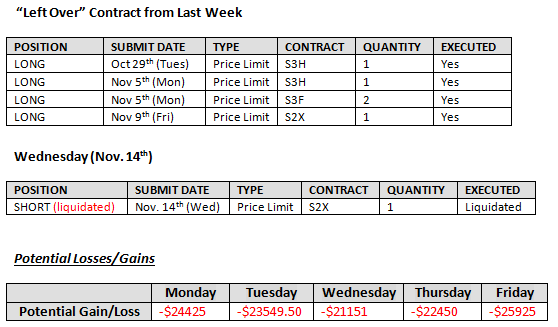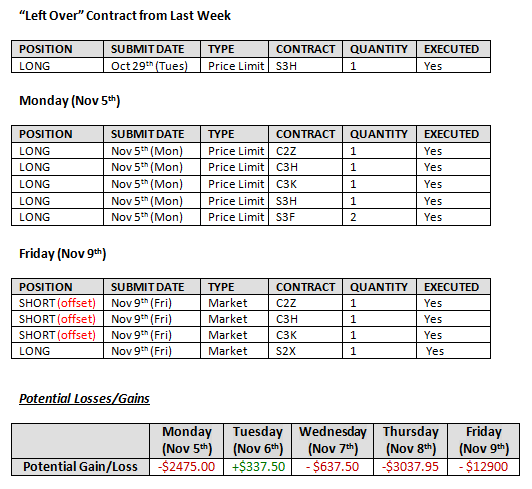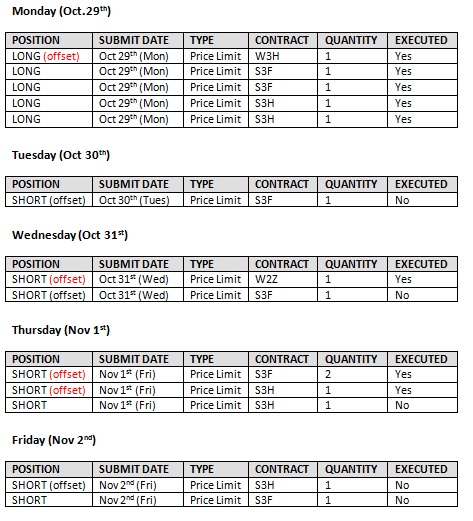Meteorologists and agronomists in the U.S.warn that the threat of the drought has not yet passed. Also, dry weather in the western U.S. is starting to severely damage the crops’ winter planting and production. Important agricultural states, such as Nebraska and Kansas have the lowest level of moisture in years. Climate experts estimate that certain areas need additionally 5 to 6 feet of snow to over 15 inches of precipitations over the next months in order for crops to revert to their normal conditions. In general, I anticipate commodity future prices to increase in the coming future, as a result of the recent disastrous weather that’s damaging the crops, along with the natural disasters that’s occurring around the world.
On the other hand, USDA was scheduled to release updated crop estimations on November 9th (Friday), which is likely to affect the commodity futures prices.
Wheat
While heavy rains hit the eastern U.S. last week when Hurricane Sandy roared, the west region remained waterless. Dry weather still remains to be a problem in the U.S. Plains winter wheat belt. Joel Widenor, a meteorologist for Commodity Weather Group, claimed that a continued lack of rain in the Plains area is likely to cause a third of the wheat crops entering winter poorly established. These areas will be vulnerable to the cold air that’s approaching. Normally, the new winter wheat crop should already be established with steady roots for the cold winter, but the wheat has only started emerging this year. Currently 15% of the U.S.winter wheat crops are rated to be very poor, 45% fair, and only 40% are ranked good to excellent. Hence, I expect wheat commodity prices to increase as winter approaches.

Looking from the technical aspect though, it appears that recent wheat futures prices have been fluctuating quite rapidly. Personally, I’m quite unlikely to be buying or selling any wheat contracts next week, as I find recent wheat market patterns quite difficult to predict, especially since I prefer offsetting all of the contracts before the end of the week if feasible. However, I might consider going LONG on one of the wheat contract that expires in 2013, and leave it in the market for a few weeks, to wait for the future prices to increase.
Corn
Analysts are suspecting some producers could switch corn acres to soybeans, as there’s concern about delayed corn planting in South America. If this happens, South America could lose to about 20% of corn production for 2012/2013 due to excessive precipitations, and flooding. Furthermore, Brazil’s trade ministry said that the country has exported a record of 3.66 million metric tons in October. The drought in the U.S. has increased the global demand for corn, and Brazil is expected to export a total of 17 million metric tons of soybean. Brazil is also exporting increasing amount of ethanol, as it is the main feedstock for ethanol in North America. However, as its stocks decreases, exporting business is gradually shifting back to the U.S., which causes the corn price to increase. On the other hand, Hurricane Sandy has improved the weather condition in the eastern Midwest region of the U.S., which is expected to aid the harvest of the final U.S. corns and soybeans. To conclude, planting concerns in the South America, and shifting of exporting market could both increase corn future prices, while improved weather condition is likely to decrease corn prices.

While news is once again pulling corn future prices both ways, from the analytical chart above, I think corn prices are highly likely to increase at the beginning of next week, unless breaking news happens over the weekend. Otherwise, I am going to go LONG in a few corn contracts at the beginning of week 9.
Soybean
Soybean futures prices were pressured, and dropped by over 30 cents on Friday. It was largely due to recent private firms’ optimistic estimations on theU.S.’ 2012 soybean and corn harvest, which were above USDA’s estimation. USDA’s October estimation for the U.S. soybean crop was 2.860 billion bushels, while INTL FCStone estimated the soybean crop to be at 2.959 billion bushels on Thursday, and Informa Economics estimated the soybean crop to be 2.925 billion bushels on Friday. USDA also mentioned that the US soybean harvest was 87% complete already. In addition, the dry weather in the western U.S. is affecting soybean planting, as well as other crops.
On the contrary, the growing concern regarding South America’s planting delay hasn’t been diminished, and it could cause producers to switch from corn acres to soybeans, which means there could be an increase in soybean production in 2012/2013. If it does occur, it could potentially decrease soybean futures prices. Also, improved weather in the eastern Midwest part of the U.S. should assist the harvesting of the final U.S. corn and soybeans for the ten days.

Soybean price dropped by more than 30 cents after CBOT closed on Friday (Nov 2nd). As shown above, the hastily fall in soybean commodity price allowed soybean prices to return to the price level they were at before they spiked three days ago (as shown above). If no breaking news occurs over the weekend, I foresee soybean future prices to drop to a stop early next week, perhaps stabilizes for a day or so, and rebound up latter during the week. Also, I doubt next week’s price fluctuations in soybean are going to be as thrilling as they were this week, especially since recent news are pulling the commodity prices both ways.
Reference
http://af.reuters.com/article/commoditiesNews/idAFL3E8M261J20121102
http://www.brecorder.com/markets/commodities/america/88605-cbot-corn-down-on-technical-selling-.html
http://www.brecorder.com/agriculture-a-allied/183/1253793/
http://futures.tradingcharts.com/intraday/ZSX2?anticache=1351922666
http://mobile.reuters.com/article/idUSBRE8A112T20121102?irpc=932
http://www.reuters.com/article/2012/11/01/us-brazil-commodities-exports-idUSBRE8A01DO20121101


























